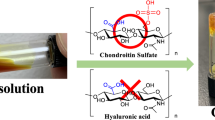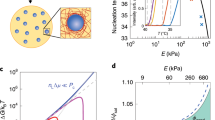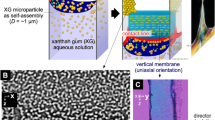Abstract
A GEL system that swells and shrinks in response to specific molecules could serve as the basis for technological applications of polymer gels, for example as sensors, drug-delivery devices and actuators. Here we describe a lectin-loaded polymer gel that undergoes distinct swelling behaviour in response to different saccharides. The gel consists of a covalently cross-linked polymer network of N-isopropylacrylamide in which the lectin, concanavalin A, is immobilized. Concanavalin A displays selective binding affinities for certain saccharides. The gel undergoes a volume phase transition at ∼34 °C. When the saccharide dextran sulphate is added (as the sodium salt DSS) to the gel, it swells to a volume up to five times greater at temperatures close to this transition, and the transition itself changes from discontinuous to continuous. Replacing DSS with the non-ionic saccharide α-methyl-D-mannopyranoside brings about collapse of the gel back to almost its native volume. This process is reversible and repeatable. These results point to a general principle for the design of such molecule-specific systems.
This is a preview of subscription content, access via your institution
Access options
Subscribe to this journal
Receive 51 print issues and online access
$199.00 per year
only $3.90 per issue
Buy this article
- Purchase on Springer Link
- Instant access to full article PDF
Prices may be subject to local taxes which are calculated during checkout
Similar content being viewed by others
References
Tanaka, T. Phys. Rev. Lett. 40, 820–823 (1978).
Dusek, K. & Patterson, D. J. Polym. Sci. A26, 1209–1216 (1968).
Tanaka, T. et al. Phys. Rev. Lett. 45, 1636–1639 (1980).
Ilavsky, M. Macromolecules 15, 782–788 (1982).
Hirokawa, Y. & Tanaka, T. J. chem. Phys. 81, 6379–6380 (1984).
Hirokawa, Y., Tanaka, T. & Katayama, S. in Microbial Adhesion and Aggregation (ed. Marshall, K.C.) 177 (Springer, Berlin, 1984).
Hrouz, J., Ilavsky, M., Ulbrich, K. & Kopecek, J. Europ. Polym. J. 17, 361–366 (1982).
Ohmine, I. & Tanaka, T. J. chem. Phys. 77, 5725–5729 (1982).
Tanaka, T., Nishio, I., Sun, S.-T. & Ueno-Nishio, S. Science 218, 467–469 (1982).
Mamada, A., Tanaka, T., Kungwatchakun, D. & Irie, M. Macromolecules 23, 1517–1519 (1990).
Suzuki, A. & Tanaka, T. Nature 346, 345–347 (1990).
Wang, J. L., Cunnginham, B. A. & Edelman, G. M. J. bid. Chem. 250, 1513–1521 (1975).
Goldstein, I. J., Hollerman, C. E. & Smith, E. E. Biochemistry 4, 876–883 (1965).
Author information
Authors and Affiliations
Rights and permissions
About this article
Cite this article
Kokufata, E., Zhang, YQ. & Tanaka, T. Saccharide-sensitive phase transition of a lectin-loaded gel. Nature 351, 302–304 (1991). https://doi.org/10.1038/351302a0
Received:
Accepted:
Issue Date:
DOI: https://doi.org/10.1038/351302a0
This article is cited by
-
Utilization of L-serinyl derivate to preparing triple stimuli-responsive hydrogels for controlled drug delivery
Journal of Polymer Research (2019)
-
Designing hydrogels for controlled drug delivery
Nature Reviews Materials (2016)
-
Crosslinker effects on swelling and gel properties of pH- and temperature-responsive poly (NIPAM/IA/AM) hydrogels
Polymer Bulletin (2016)
-
Synthesis and properties of a dual responsive hydrogel by inverse microemulsion polymerization
Journal of Chemical Sciences (2014)
-
Preparation and characterization of sodium alginate/poly(N-isopropylacrylamide)/clay semi-IPN magnetic hydrogels
Polymer Bulletin (2012)
Comments
By submitting a comment you agree to abide by our Terms and Community Guidelines. If you find something abusive or that does not comply with our terms or guidelines please flag it as inappropriate.



